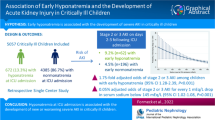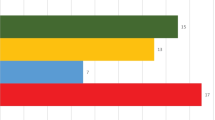Abstract
Purpose
To determine the factors affecting mortality as a result of the analysis of the demographic and clinical characteristics and laboratory parameters of patients whose serum Na value was determined to be 125 mEq/L or below at the time of admission to the emergency department (ED).
Method
Patients over 18 years of age who admitted to the ED of a tertiary hospital between September 2021 and September 2022 and whose serum sodium level was determined to be 125 mEq/L and below were included in the study. Demographic and clinical characteristics, admission complaints, medications used, Charles comorbidity index (CCI), laboratory parameters, and outcomes of the patients included in the study were recorded in the data form.
Results
Three hundred ninety-nine patients were included in the study. When the 30-day mortality of the patients is examined, the mortality rate was found to be 21.6%. In the analyses performed for the predictive power of laboratory parameters for mortality, it was determined that the highest predictive power among the predictive values determined by the area under the curve (AUC) was the albumin level (AUC 0.801, 95% CI 0.753–0.849, p < 0.001). In the binary logistic regression analysis, urea and albumin were independent predictors of 30-day mortality.
Conclusion
According to study data, albumin and urea levels are independent predictors of 30-day mortality in patients diagnosed with severe hyponatremia in the emergency department.


Similar content being viewed by others
Availability of data and material
The full dataset on which analyses were run is available upon written request to the corresponding author.
References
Hsu YJ, Chiu JS, Lu KC et al (2005) Biochemical and etiological characteristics of acute hyponatremia in the emergency department. J Emerg Med 29(4):369–374
Nguyen MK, Ornekian V, Butch AW et al (2007) A new method for determining plasma water content: application in pseudohyponatremia. Am J Physiol Renal Physiol 292:F1652–F1656
Rose BD, Post TW (2001) Clinical physiology of acid-base and electrolyte disorders, 5th edn. McGraw-Hill, New York, p 699
Katz MA (1973) Hyperglycemia-induced hyponatremia calculation of expected serum sodium depression. N Engl J Med 289(16):843–844
Bähr V, Franzen NF, Pfeiffer AF et al (2006) Vasopressin excess and hyponatremia: hydrocortisone treatment should be considered. Am J Kidney Dis 48(2):339
Spasovski G, Vanholder R, Allolio B et al (2014) Clinical practice guideline on diagnosis and treatment of hyponatraemia. Nephrol Dial Transplant 29(2):1–39
Hoorn EJ, Zietse R (2017) Diagnosis and treatment of hyponatremia: compilation of the guidelines. J Am Soc Nephrol 28(5):1340–1349
Ball SG, Iqbal Z (2016) Diagnosis and treatment of hyponatraemia. Best Pract Res Clin Endocrinol Metab 30(2):161–173
Upadhyay A, Jaber BL, Madias NE (2006) Incidence and prevalence of hyponatremia. Am J Med 119(1):30–35
Christ-Crain M (2016) Profound hyponatraemia in the emergency department: a hot topic. Swiss Med Wkly 146:14396
Olsson K, Öhlin B, Melander O (2013) Epidemiology and characteristics of hyponatremia in the emergency department. Eur J Intern Med 24(2):110–116
Mohan S, Gu S, Parikh A et al (2013) Prevalence of hyponatremia and association with mortality: results from NHANES. Am J Med 126(12):1127–1137
Terzian C, Frye EB, Piotrowski ZH (1994) Admission hyponatremia in the elderly: factors influencing prognosis. J Gen Intern Med 9(2):89–91
Giordano M, Ciarambino T, Castellino P et al (2016) Diseases associated with electrolyte imbalance in the ED: age-related differences. Am J Emerg Med 34(10):1923–1926
Lindner G, Pfortmuller CA, Leichtle AB et al (2014) Age-related variety in electrolyte levels and prevalence of dysnatremias and dyskalemias in patients presenting to the emergency department. Gerontology 60(5):420–423
Chewcharat A, Thongprayoon C, Cheungpasitporn W et al (2020) Trajectories of serum sodium on ın-hospital and 1-year survival among hospitalized patients. Clin J Am Soc Nephrol 15:600–607
Thongprayoon C, Cheungpasitporn W, Petnak T et al (2020) The prognostic importance of serum sodium levels at hospital discharge and one-year mortality among hospitalized patients. Int J Clin Pract 74:13581
Zilberberg MD, Exuzides A, Spalding J et al (2008) Hyponatremia and hospital outcomes among patients with pneumonia: a retrospective cohort study. BMC Pulm Med 8:16
Klein L, O’Connor CM, Leimberger JD, OPTIME-CHF ınvestigators et al (2005) Lower serum sodium is associated with increased short-term mortality in hospitalized patients with worsening heart failure: results from the outcomes of a prospective trial of intravenous milrinone for exacerbations of chronic heart failure (OPTIME-CHF) study. Circulation 111:2454–2460
Waikar SS, Mount DB, Curhan GC (2009) Mortality after hospitalization with mild, moderate, and severe hyponatremia. Am J Med 122:857–865
Kim WR, Biggins SW, Kremers WK et al (2008) Hyponatremia and mortality among patients on the liver-transplant waiting list. N Engl J Med 359:1018–1026
Stelfox HT, Ahmed SB, Khandwala F et al (2008) The epidemiology of intensive care unit-acquired hyponatraemia and hypernatraemia in medical-surgical intensive care units. Crit Care 12:R162
Clayton JA, Le Jeune IR, Hall IP (2006) Severe hyponatremia in medical in-patients: aetiology, assessment and outcome. Q J Med 99:505–511
Renneboog B, Musch W, Vandemergel X et al (2006) Mild chronic hyponatremia is associated with falls, unsteadiness and attention deficits. Am J Med 119:711–718
Kengne FG, Andres C, Sattar L et al (2008) Mild hyponatremia and risk of fracture in the ambulatory elderly. Q J Med 101:583–588
Charlson M, Pompei P, Ales K, MacKenzie C (1987) A new method of classifying prognostic comorbidity in longitudinal studies: development and validation. J Chronic Dis 40:373–383
Dağar S, Akıncı Emektar E, Çorbacıoğlu ŞK et al (2019) Medico-legal evaluation of geriatric patients and mortality predictors in the elderly with forensic trauma. Ankara Med J 19(4):761–768
Liamis G, Filippatos TD, Elisaf MS (2016) Thiazide-associated hyponatremia in the elderly: what the clinician needs to know. J Geriatr Cardiol 13(2):175–182
Huwyler T, Stirnemann J, Vuilleumier N et al (2016) Profound hyponatraemia in the emergency department: seasonality and risk factors. Swiss Med Wkly 146:14385
Jain AK, Nandy P (2019) Clinico-etiological profile of hyponatremia among elderly age group patients in a tertiary care hospital in Sikkim. J Family Med Prim Care 8(3):988–994
Abramow M, Cogan E (1984) Clinical aspects and pathophysiology of diuretic-induced hyponatremia. Adv Nephrol Necker Hosp 13:1–28
Sonnenblick M, Friedlander Y, Rosin AJ (1993) Diuretic-induced severe hyponatremia: review and analysis of 129 reported patients. Chest 103(2):601–606
Rao MY, Sudhir U, Anil Kumar T et al (2010) Hospital-based descriptive study of symptomatic hyponatremia in elderly patients. J Assoc Physicians India 58:667–669
Turgutalp K, Ozhan O, Gok Oguz E et al (2013) Clinical features, outcome and cost of hyponatremia-associated admission and hospitalization in elderly and very elderly patients: a single-center experience in Turkey. Int Urol Nephrol 45(1):265–273
Gosch M, Joosten-Gstrein B, Heppner H-J et al (2012) Hyponatremia in geriatric inhospital patients: effects on results of a comprehensive geriatric assessment. Gerontology 58(5):430–440
Zhang X, Li XY (2020) Prevalence of hyponatremia among older inpatients in a general hospital. Eur Geriatr Med 11(4):685–692
Morris PE, Griffin L, Berry M et al (2011) Receiving early mobility during an intensive care unit admission is a predictor of improved outcomes in acute respiratory failure. Am J Med Sci 341(5):373–377
Keil DS, Gross S, Seymour RB et al (2018) Mortality after high-energy pelvic fractures in patients of age 65 years or older. J Orthop Trauma 32(3):124–128
Matsuo K, Mandelbaum RS, Adams CL et al (2019) Performance and outcome of pelvic exenteration for gynecologic malignancies: a population-based study. Gynecol Oncol 153(2):368–375
Winzeler B, Jeanloz N, Nigro N et al (2016) Long-term outcome of profound hyponatremia: a prospective 12 months follow-up study. Eur J Endocrinol 175(6):499–507
Bozkurt Babuş S, Köse A, Erdogan S et al (2023) Risk factors and mortality in elderly patients with severe hyponatremia admitted to the emergency department. Ir J Med Sci 192(2):861–870
Hao J, Li Y, Zhang X et al (2017) The prevalence and mortality of hyponatremia is seriously underestimated in Chinese general medical patients: an observational retrospective study. BMC Nephrol 18:328
Liamis G, Milionis HJ, Elisaf M (2011) Hyponatremia in patients with infectious diseases. J Infect 63(5):327–335
Lee CT, Guo HR, Chen JB (2000) Hyponatremia in the emergency department. Am J Emerg Med 18(3):264–268
Arampatzis S, Frauchiger B, Fiedler GM et al (2012) Characteristics, symptoms, and outcome of severe dysnatremias present on hospital admission. Am J Med 125(11):1125–2112
Ellison DH, Berl T, Clinical practice (2007) The syndrome of inappropriate antidiuresis. N Engl J Med 356(20):2064–2072
Cuesta M, Slattery D, Goulden EL et al (2019) Hyponatraemia in patients with community-acquired pneumonia; prevalence and aetiology, and natural history of SIAD. Clin Endocrinol (Oxf) 90(5):744–752
Chung HM, Kluge R, Schrier RW, Anderson RJ (1987) Clinical assessment of extracellular fluid volume in hyponatremia. Am J Med 83(5):905–908
Pham PC, Pham PM, Pham PT (2006) Vasopressin excess and hyponatremia. Am J Kidney Dis 47(5):727–737
Dandona P, Fonseca V, Baron DN (1985) Hypoalbuminaemic hyponatraemia: a new syndrome? Br Med J (Clin Res Ed) 291(6504):1253–1255
Zoellner H, Hofler M, Beckmann R et al (1996) Serum albumin is a specific inhibitor of apoptosis in human endothelial cells. J Cell Sci 109(10):2571–2580
Fleck A, Hawker F, Wallace P et al (1985) Increased vascular permeability: a major cause of hypoalbuminaemia in disease and injury. The Lancet 325(8432):781–784
Nicholson JP, Wolmarans MR, Park GR (2000) The role of albumin in critical illness. Br J Anaesth 85:599–610
Goldwasser P, Feldman J (1997) Association of serum albumin and mortality risk. J Clin Epidemiol 50(6):693–703
Knaus WA, Wagner DP, Draper EA et al (1991) The APACHE III prognostic system: risk prediction of hospital mortality for critically III hospitalized adults. Chest 100(6):1619–1636
Investigators SS (2004) A comparison of albumin and saline for fluid resuscitation in the intensive care unit. N Engl J Med 350(22):2247–2256
Tanemoto M (2008) Effect of serum albumin on serum sodium: necessity to consider the Donnan effect. QJM 101(10):827–828
Pan SW (2013) Synergistic impact of low serum albumin on intensive care unit admission and high blood urea nitrogen during intensive care unit stay on post intensive care unit mortality in critically ill elderly patients requiring mechanical ventilation. Geriatr Gerontol Int 13(1):107
Tokgöz Akyıl F, Akyıl M, Çoban Agca M et al (2019) Hyponatremia prolongs hospital stay and hypernatremia better predicts mortality than hyponatremia in hospitalized patients with community-acquired pneumonia. Tuberk Toraks 67(4):239–247
Author information
Authors and Affiliations
Contributions
MG, SA, SS, MG, SS, CI, and EO conceived and designed the study; MG, SA, SS, MG, and EO selected the articles and extracted the data; MG, SA, MG, SS, and CI analyzed the data and interpreted the results; MG, SA, SS, MG, SS, CI, and EO contributed to writing the final version of the manuscript. All authors agreed with the results and conclusions of this article.
Corresponding author
Ethics declarations
Conflict of interest
The authors declare no competing interests.
Additional information
Publisher's Note
Springer Nature remains neutral with regard to jurisdictional claims in published maps and institutional affiliations.
Rights and permissions
Springer Nature or its licensor (e.g. a society or other partner) holds exclusive rights to this article under a publishing agreement with the author(s) or other rightsholder(s); author self-archiving of the accepted manuscript version of this article is solely governed by the terms of such publishing agreement and applicable law.
About this article
Cite this article
Gurbuz, M., Acehan, S., Satar, S. et al. Mortality predictors of patients diagnosed with severe hyponatremia in the emergency department. Ir J Med Sci (2024). https://doi.org/10.1007/s11845-024-03615-7
Received:
Accepted:
Published:
DOI: https://doi.org/10.1007/s11845-024-03615-7




